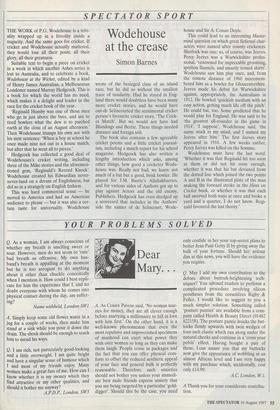SPECTATOR SPORT
Wodehouse at the crease
Simon Barnes
THE WORK of P.G. Wodehouse is a trivi- ality wrapped up in a frivolity inside a nugacity. And the same goes for cricket. If cricket and Wodehouse actually mattered, they would lose all their point, all their glory, all their greatness.
Suitable text to begin a piece on cricket in a week in which another Ashes series is lost to Australia, and to celebrate a book, Wodehouse at the Wicket, edited by a kind of Henry James Australian, a Melbournian Londoner named Murray Hedgcock. This is a book for which the world has no need, which makes it a delight and leader in the race for the cricket book of the year.
`Reginald Humby was one of those men who go in just above the byes, and are to tired bowlers what the dew is to parched earth at the close of an August afternoon.' Then Wodehouse trumps his own ace with his next sentence: 'When a boy at school he once made nine not out in a house match, but after that he went all to pieces.'
Hedgcock has collected a good deal of Wodehouses's cricket writing, including three of the Mike stories and the aforemen- tioned gem, 'Reginald's Record Knock'. Wodehouse created his Edwardian never- never-land on a dream of Englishness, but did so in a strangely un-English fashion.
This was hard commercial sense — he moved to America and had an American audience to please — but it was also a cer- tain taste for universality. Wodehouse wrote of the besieged class of an island race, but he did so without the smallest trace of insularity. Had he stayed in Eng- land there would doubtless have been many more cricket stories, and he would have out-de Selincourted the sentimental cricket person's favourite cricket story, The Crick- et Match'. But we would not have had Blandings and Bertie. These things needed distance and foreign soil.
The book also contains a few agreeable cricket poems and a little cricket journal- ism, including a match report for his school magazine. Hedgcock has also written a lengthy introduction which asks, among other things, how good a cricketer Wode- house was. Really not bad, we learn: not much of a bat but a good, brisk bowler. He played for J.M. Barrie's Allahakbarries, and for various sides of Authors got up to play against Actors and the old enemy, Publishers. Hedgcock has even dredged up a scorecard that includes in the Authors' side the names of de Selincourt, Wode- house and Sir A. Conan Doyle.
This could lead to an interesting Master- mind question on which great fictional char- acters were named after county cricketers. Sherlock was one; so, of course, was Jeeves. Percy Jeeves was a Warwickshire profes- sional, 'renowned for impeccable grooming, spotless flannels, and smartly ironed shirts'. Wodehouse saw him play once, and, from the remote distance of 1960 misremem- bered him as a bowler for Gloucestershire. Jeeves made his debut for Warwickshire against, appropriately, the Australians in 1912. He bowled `quickish medium with an easy action, getting much life off the pitch'. He could bat, too. Some predicted that he would play for England. He was said to be `the greatest all-rounder in the game in 1914'. 'I suppose', Wodehouse said, 'the name stuck in my mind, and I named my Jeeves after him.' The first Jeeves story appeared in 1916. A few weeks earlier, Percy Jeeves was killed on the Somme.
Wodehouse must have the last word. `Whether it was that Reginald hit too soon at them or did not hit soon enough, whether it was that his bat deviated from the dotted line which joined the two points A and B in the illustrated plate of the man making the forward stroke in the Hints on Cricket book, or whether it was that each ball swerved both ways at once and broke a yard and a quarter, I do not know. Regi- nald favoured the last theory.'


























































 Previous page
Previous page